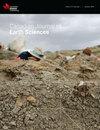Late Quaternary changes in sediment sources in the Labrador Sea
IF 1.6
4区 地球科学
Q3 GEOSCIENCES, MULTIDISCIPLINARY
引用次数: 1
Abstract
Quaternary sediment in the Labrador Sea was derived from many proglacial sources in Greenland and eastern Canada. Understanding the spatial and temporal changes in sediment provenance provides information on ice extent and sediment dispersal patterns. Variations in mineral composition of sediment from late Quaternary cores has been determined by a whole pattern quantitative X-ray diffraction procedure. Mineral facies were extracted statistically by a supervised analysis of 90 samples from bedrock and ice-rafted clasts, which were then used to predict the most probable mineral facies in 1443 marine sediment samples. We used a non-parametric Classification Decision Tree (CDT) to validate that decision. Only 26% of the samples were misclassified in the CDT. The six facies identified consisted of four facies reflecting differences in the composition of Canadian and Greenland Precambrian igneous and metamorphic bedrock, a set of samples dominated by high wt%s of calcite and dolomite (detrital carbonate (DC) and Hudson Strait Heinrich (HS-H) events), and a “shale” facies. We isolated 284 sediments from the HS-H detrital carbonate facies and determined that they could be divided into four categories based on differences in their mineral proportions. These categories vary geographically, based on non-carbonate sediment supply during these events from Greenland, the Canadian Shield, the Appalachians and the outer continental shelf. In the Holocene of the Labrador Sea, dolomite is derived from Baffin Bay and abundance of calcite is influenced by both biogenic productivity and dissolution.拉布拉多海沉积物来源的晚第四纪变化
拉布拉多海的第四纪沉积物来自格陵兰岛和加拿大东部的许多前冰期沉积物。了解沉积物物源的时空变化可以提供有关冰的范围和沉积物扩散模式的信息。用全谱定量x射线衍射方法测定了晚第四纪岩心沉积物矿物组成的变化。通过对90个基岩和冰筏碎屑样本的监督分析,统计地提取了矿物相,然后将其用于预测1443个海洋沉积物样本中最可能的矿物相。我们使用非参数分类决策树(CDT)来验证该决策。只有26%的样本在CDT中被错误分类。确定的6个相包括反映加拿大和格陵兰前寒武纪火成岩和变质基岩组成差异的4个相,一组以高wt%s的方解石和白云岩(碎屑碳酸盐岩(DC)和哈德逊海峡海因里希(HS-H)事件)为主的样品,以及一个“页岩”相。从HS-H碎屑碳酸盐相中分离出284个沉积物,根据其矿物比例的差异将其分为4类。这些类别在地理上有所不同,根据这些事件期间来自格陵兰岛、加拿大地盾、阿巴拉契亚山脉和外大陆架的非碳酸盐沉积物供应。拉布拉多海全新世白云岩产自巴芬湾,方解石丰度受生物生产力和溶蚀作用的双重影响。
本文章由计算机程序翻译,如有差异,请以英文原文为准。
求助全文
约1分钟内获得全文
求助全文
来源期刊

Canadian Journal of Earth Sciences
地学-地球科学综合
CiteScore
2.80
自引率
7.10%
发文量
66
审稿时长
6-12 weeks
期刊介绍:
The Canadian Journal of Earth Sciences reports current research in climate and environmental geoscience; geoarchaeology and forensic geoscience; geochronology and geochemistry; geophysics; GIS and geomatics; hydrology; mineralogy and petrology; mining and engineering geology; ore deposits and economic geology; paleontology, petroleum geology and basin analysis; physical geography and Quaternary geoscience; planetary geoscience; sedimentology and stratigraphy; soil sciences; and structural geology and tectonics. It also publishes special issues that focus on information and studies about a particular segment of earth sciences.
 求助内容:
求助内容: 应助结果提醒方式:
应助结果提醒方式:


